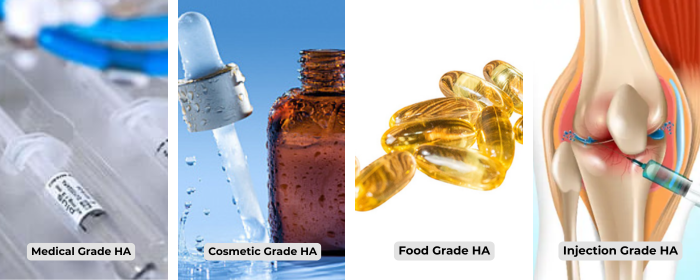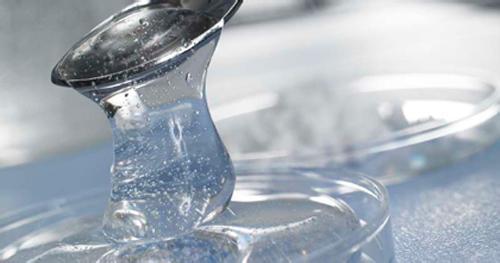How to Choose Molecular Weight? Instructions for Use on Different Sodium Hyaluronates
Sodium hyaluronate (hyaluronic acid, HA) is of some thousands to a few millions of Daltons (Da) molecular weight (MW). Physical properties and biological functions such as viscosity, permeability, moisturization, anti-inflammatory action, lubrication depend altogether only on molecular weight variation. Therefore, when selecting sodium hyaluronate, one should select the most suitable molecular weight based on the application.
Classification by Application: 4 Types of Sodium Hyaluronate
Depending on their uses, sodium hyaluronate can be divided into four grades: Medical Grade, Cosmetic Grade, Food Grade, and Injection Grade.
Medical Grade HA
For the pharmaceutical industry, hyaluronic acid is used primarily for ophthalmic surgery, orthopedic injections, wound dressings, and drug delivery systems. Medical-grade HA is subjected to very strict purity and molecular weight distribution requirements, generally needing to comply with pharmacopeial criteria and low endotoxin levels. Each application may have different molecular weight requirements. This article provides a detailed introduction: Medical-Grade Hyaluronic Acid: From Ophthalmic to Multidisciplinary Therapeutic Agent
Cosmetic Grade Sodium Hyaluronate
The cosmetics industry utilizes hyaluronic acid due to its moisturizing and anti-aging effects. It is found in creams, serums, and injectable fillers. Cosmetics-grade sodium hyaluronate typically varies in molecular weight to provide a balance between skin permeability and moisturization. Lower molecular weights can penetrate deeper into the skin, enhancing internal moisturizing effects. Higher molecular weights form a protective layer on the skin’s surface to lock in moisture.
Food Grade HA
In food, sodium hyaluronate is used as a food additive and dietary supplement due to its health effects. Detailed benefits can be found below: What Are the Benefits of Food-Grade Hyaluronic Acid. Since it is taken orally, food-grade hyaluronic acid must meet high purity standards. It is also usually produced at lower molecular weights for absorption in the gastrointestinal tract.
Injection Grade Sodium Hyaluronate
Sodium hyaluronate injection grade is used mainly for intra-articular injections and medical aesthetics. Both these applications require rigorous molecular weight specifications to ensure stability, longevity, and biocompatibility.
Molecular Weight Determines the Uses of Sodium Hyaluronate
Molecular weight of sodium hyaluronate plays a critical role in determining its physical and biological properties, which subsequently decides its applications.
Viscosity and Moisturizing Capacity
Higher molecular weight hyaluronic acid has higher viscosity and higher moisturizing capacity. It is therefore used in medical-grade applications requiring long-term lubrication and support. In cosmetic applications, higher molecular weights help form a moisturizing film on the skin surface, fortifying the skin’s moisture barrier.
Skin Penetration and Absorption
Low molecular weight sodium hyaluronate has shorter chains of molecules that allow it to penetrate deeper into the layers of the skin. It is particularly beneficial in cosmetic applications for enhanced moisturizing and active ingredient delivery. High molecular weight sodium hyaluronate, however, can remain at the skin’s surface to provide instant moisture and form a protective barrier.
Biocompatibility and Degradability
Molecular weight in medical and injection applications affects the activity of sodium hyaluronate with body tissues. High MW sodium hyaluronate is typically more biocompatible and breaks down more slowly. This gives a longer duration of action in tissue engineering and dermal fillers. Lower MW molecules break down faster, which is beneficial for short-term applications or where rapid clearance from the body is desired.
Bioavailability of Supplements
For the food additive sodium hyaluronate, molecular weight determines its ease of absorption and efficacy as a food supplement. Lower molecular weights ensure rapid absorption in the gastrointestinal tract, thereby enhancing their impact on joint function and skin elasticity.
The table 1 below provides a comparison of the molecular weight ranges required for different applications.
Table 1. How to Choose Molecular Weight for Difference Applications
| Application | Core Requirements | Recommended MW Range | Recommended Products |
| Ophthalmic Viscous Agents | High viscoelasticity, support, maintaining surgical space | 1,000–2500 kDa | HA-EM3.0-SC |
| Eye Drops | Lubrication, moisturization, low viscosity to prevent blurring | 50–500 kDa | HA-EM2.0-SC |
| Joint Injections | Long-lasting lubrication, high viscoelasticity | 2000–3000 kDa | HA-EP3.0-SC |
| Wound Dressings | Promote cell migration, anti-inflammatory | 10–100 kDa | HA-EMC-SC |
| Creams | Surface film formation, long-lasting moisture retention | 300–1000 kDa | HAC-N-SC, HAC-L-SC |
| Emulsions | Balance penetration and moisturization | 100–300 kDa | HAC-N-SC |
| Anti-Aging Serums | Transdermal absorption, stimulate collagen synthesis | 10–50 kDa (can be blended with 1-10 kDa) | HAC-Oligo-SC, HAC-Micro-SC |
| Oral Beverages | Easily absorbed by the intestines, high bioavailability | <50 kDa | HAF-Oligo-SC, HAF-Micro-SC |
* Stanford Chemical Company (SCC) is a wholesale distributor of pure organic hyaluronic acid in the United States. Each grade HA is available in high, medium, and low molecular weights.
Clarifying Misconceptions
Although sodium hyaluronate has widespread applications, there are still individuals who have misconceptions about it. Most of these are due to individuals not knowing its molecular weight and applications.
Misconception 1: Higher Molecular Weight is Always Better
Although HMW sodium hyaluronate possesses more viscosity and moisturizing properties, it is not universally suitable. Different applications require certain molecular weights to create the desired effect. For example, in cosmetics, LMW HAs are preferable for deep penetration of the skin; whereas in medical-grade applications, HMW HAs are required to provide long-lasting lubrication and support.
Reference: High VS. Low Molecular Weight Hyaluronic Acid
Misconception 2: All Sodium Hyaluronate is the Same
The molecular weight and purity of sodium hyaluronate vary depending on its applications. Cosmetic-grade, Food-grade, Injection-grade, and Medical-grade are formulated differently with diverse specifications in order to meet the strict requirements of their respective industries. Using the wrong grade will result in subpar performance or even safety issues.
Reference: Medical Grade vs. Cosmetic Grade Hyaluronic Acid: What Are the Differences
Misconception 3: Sodium Hyaluronate is Only Used in Skin and Joints
Although sodium hyaluronate is widely known for its applications in skincare and joint care, its applications are more extensive, including ophthalmology, dentistry, wound healing, and even hair care. Every application entails exploiting different properties of sodium hyaluronate, which are altered based on its molecular weight and composition.
Misconception 4: Higher Purity Always Means Better Performance
Purity is essential, especially for injection and medical applications. However, extremely high purity at times may compromise other desirable characteristics, such as biological activity. The ratio between molecular weight and purity will depend on the target application and desired effect.


